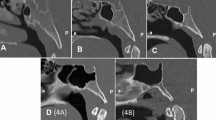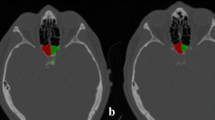Abstract
The objective of this study is to investigate the correlation between inferior turbinate size and paranasal sinus opacification on computerized tomography (CT) scans. Paranasal sinus CT scans of a total of 185 patients (92 males, 93 females) were examined in terms of sinus opacification. Sizes of the inferior turbinates were measured using stereological method and these sizes in normal and opacified paranasal sinuses are compared using one-way analysis of variance. Scans of 185 patients (93 female, 92 male) aged between 12 and 84 (mean 37.85 ± 16.27) years were examined in this study. Sizes of the inferior turbinates were found to be increased significantly in case of opacification of ipsilateral maxillary and anterior ethmoid sinuses (p = 0.000 and p = 0.4, respectively) on both sides. On the other hand, such a relationship could not be demonstrated for sizes of inferior turbinates with opacified or non-opacified posterior ethmoid, frontal and sphenoid sinuses. In conclusion, the combination of CT and the Cavalieri principle can provide an unbiased, direct, and assumption-free estimate of the regions of interest. The presented method can be efficiently applied without any need for special software, additional equipment, or personnel than that required for routine CT in daily use. Paranasal sinus disease, especially the inflammatory diseases of maxillary and anterior ethmoid sinuses, must be carefully investigated in cases with inferior turbinate hypertrophy.

Similar content being viewed by others
References
Farmer SE, Eccles R (2006) Chronic inferior turbinate enlargement and the implications for surgical intervention. Rhinology 44:234–238
Berger G, Gass S, Ophir D (2006) The histopathology of the hypertrophic inferior turbinate. Arch Otolaryngol Head Neck Surg 132:588–594
Emirzeoglu M, Sahin B, Bilgic S, Celebi M, Uzun A (2007) Volumetric evaluation of the paranasal sinuses in normal subjects using computer tomography images: a stereological study. Auris Nasus Larynx 34:191–195
Annesi-Maesano I, Didier A, Klossek M, Chanal I, Moreau D, Bousquet J (2002) The score for allergic rhinitis (SFAR): a simple and valid assessment method in population studies. Allergy 57:107–114
Akbas H, Sahin B, Eroglu L, Odaci E, Bilgic S, Kaplan S et al (2004) Estimation of breast prosthesis volume by the Cavalieri principle using magnetic resonance images. Aesthetic Plast Surg 28:275–280
Bilgic S, Sahin B, Sonmez OF, Odaci E, Colakoglu S, Kaplan S et al (2005) A new approach for the estimation of intervertebral disc volume using the Cavalieri principle and computed tomography images. Clin Neurol Neurosurg 107:282–288
Emirzeoglu M, Sahin B, Selcuk MB, Kaplan S (2005) The effects of section thickness on the estimation of live volume by the Cavalieri principle using computed tomograhpy images. Eur J Radiol 56:391–397
Sahin B, Ergur H (2006) Assessment of the optimum section thickness for the estimation of liver volume using magnetic resonance images: a stereological gold standard study. Eur J Radiol 57:96–101
Gundersen HJG, Jensen EB (1987) The efficiency of systematic sampling in stereology and its prediction. J Microsc 147:229–263
Sahin B, Emirzeoglu M, Uzun A, Incesu L, Bek Y, Bilgic S et al (2003) Unbiased estimation of the liver volume by the Cavalieri principle using magnetic resonance images. Eur J Radiol 47:164–170
Howard CV, Reed MG (1998) Unbiased stereology. Three-dimensional measurement in microscopy. Bios, Oxford, pp 55–68
Gadeberg P, Gundersen HJG, Taagehoj F, Jakobsen J (2002) MRI volume measurements of hypointense objects. A phantom study using stereological methods. J Neurosci Methods 114:149–157
Stocchetti N, Croci M, Spagnoli D, Gilardoni F, Resta F, Colombo A (2000) Mass volume measurement in severe head injury: accuracy and feasibility of two pragmatic methods. J Neurol Neurosurg Psychiatry 68:14–17
Heymsfield SB, Fulenwider T, Nordlinger B, Barlow R, Sones P, Kutner M (1979) Accurate measurement of liver, kidney, and spleen volume and mass by computerized axial tomography. Ann Intern Med 90:185–187
Henderson JM, Heymsfıeld SB, Horowitz J, Kutner MH (1981) Measurement of liver and spleen volume by computed tomography. Assessment of reproducibility and changes found following a selective distal splenorenal shunt. Radiology 141:525–527
Albright R Jr, Fram EK (1988) Microcomputer-based technique for 3-D reconstruction and volume measurement of computer tomographic images. Part 1: phantom studies. Invest Radiol 23:881–885
Albright R Jr, Fram EK (1988) Microcomputer-based technique for 3-D reconstruction and volume measurement of computed tomographic images. Part 2: anaplastic primary brain tumors. Invest Radiol 23:886–890
Clatterbuck RE, Sipos EP (1997) The efficient calculation of neurosurgically relevant volumes from computed tomographic scans using Cavalieri’s direct estimator. Neurosurgery 40:339–342
Odaci E, Sahin B, Sonmez OF, Kaplan S, Bas O, Bilgic S et al (2003) Rapid estimation of the vertebral body volume: a combination of the Cavalieri principle and computed tomography images. Eur J Radiol 48:316–326
Diab KM, Ollmar S, Sevastik JA, Willers U, Svensson A (1998) Volumetric determination of normal and scoliotic vertebral bodies. Eur Spine J 7:282–288
Mazonakis M, Damilakis J, Varveris H (1998) Bladder and rectum volume estimations using CT and stereology. Comput Med Imaging Graph 22:195–201
Sahin B, Mazonakis M, Akan H, Kaplan S, Bek Y (2008) Dependence of computed tomography volume measurements upon section thickness: an application to human dry skulls. Clin Anat 21:479–485
Mabry RL, King HC (1997) The development of otolaryngic allergy in the United States. Laryngoscope 107:158–160
Acknowledgments
No financial support was received for this paper.
Conflict of interest
The authors declare no competing interest.
Author information
Authors and Affiliations
Corresponding author
Rights and permissions
About this article
Cite this article
Ural, A., Songu, M., Adibelli, Z.H. et al. A stereological study on the correlation of inferior turbinate hypertrophy and paranasal sinus disease. Eur Arch Otorhinolaryngol 271, 2437–2441 (2014). https://doi.org/10.1007/s00405-013-2874-5
Received:
Accepted:
Published:
Issue Date:
DOI: https://doi.org/10.1007/s00405-013-2874-5




